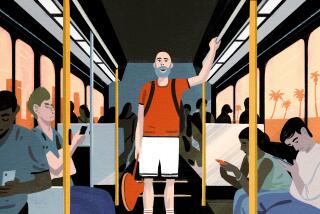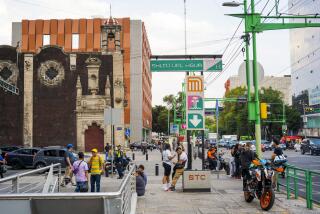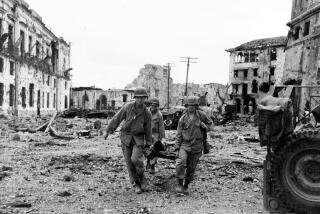Culture : For a Taxi on the Cheap, Try Taking a Jeepney : Manila’s most splendiferous vehicles parade in a colorful blur of U.S. flags, religious expressions and dancing lights. They are souped-up legacies of surplus U.S. Army jeeps.
- Share via
MANILA — It is afternoon rush hour in Manila, and Rudy Aquino, squinting behind the wheel of “Taurus,” is driving like a man possessed.
His gleaming-steel jeepney lurches down Taft Avenue, belching a black cloud of diesel exhaust. He cuts hard left by “Starlight Express,” another jeepney with off-color U.S. flags, eagles and a giant, green $100 bill with a cross-eyed Benjamin Franklin on the sides. Aquino quickly downshifts past a red and blue “God Is With Us,” emblazoned with a leering Popeye and dancing mermaids. Muscling past “Hercules,” Aquino hits his horn in pleasure: It whoops, like a gibbon.
In the rear, 18 commuters are crammed knee-to-knee on two benches under a gray-sequined-leather-and-mirror ceiling. As dusk falls, Aquino flips a switch, sending tiny red and green “dancing lights” blinking in starburst patterns across the dashboard and overhead console. In the rear, purple neon gives passengers a Day-Glo pallor. Deafening disco music, booming from huge speakers, almost drowns out the thundering traffic.
Manila’s traffic is often described as a deadly nightmare, but thanks to jeepneys, at least it’s in living color. Indeed, jeepneys--originally derived from surplus U.S. Army jeeps after World War II and now usually adorned with wild paintings, yellow fog lights, “bionic horns” and much, much more--are both the country’s best-known mass transit and most popular folk art form.
“It’s our symbol, a way of showing our culture,” said Orlando Peres, 42, a factory supervisor who commutes three hours a day in kitsch-covered jeepneys. “Like fiestas and cockfights.”
President Fidel V. Ramos discovered how popular they are when his recent proposal to progressively ban jeepneys from the city’s busiest thoroughfares triggered threats of mass strikes and violent demonstrations.
With 80,000 drivers and owners, and an estimated 8 million passengers a day, the jeepney lobby is clearly a potent political force. Just last year, buses were burned and homemade bombs planted in protest against a diesel fuel price boost that would have directly hit jeepney owners.
“If they try to phase out jeepneys, we will fight like before,” promised Edgar Cauan, 33, clenching a cigarette in his teeth as he drove “Ishmael.” The vehicle was decorated with a huge Mickey Mouse figure dressed as the Statue of Liberty and a red Playboy Bunny flag hanging where the driver’s door would be if jeepneys had doors.
Ramos quickly backpedaled on his plan, which now appears as stalled as “Wild Thing,” a jeepney blocking traffic in the middle lane, its nine tall antennas and pink tassels wiggling in the warm wind.
“When we say ‘phase out jeepneys from Manila,’ we don’t really mean that,” Jesus B. Garcia Jr., Ramos’ secretary of transportation and communication, explained in an interview. “The phase-out is more an expression.”
Instead, he said, the government hopes to build a second light-rail transit line, use more minibuses and offer tax incentives and other inducements to persuade jeepney drivers to use secondary roads. “We don’t believe in enforcement with a stick,” he explained. “We’d rather use a carrot.”
Enforcement is unlikely anyway. No single police agency is responsible for traffic in this unruly capital, leaving the field open for different groups with different uniforms to collect impromptu fines for real and imagined infractions. One group, known as “brown cows” for their tight tunics over bulging bellies, shows up each noon to shake down passing drivers for lunch money.
The groups compete, Garcia explained. “Some are happy if there are traffic violations.” He shook his head sadly. “Corruption is very bad, very bad. It’s almost endemic.”
To prove the point, he reached into his back pocket and pulled out a green plastic folder containing his driver’s license--and a visible 100-peso bill, about $4, in case he gets stopped.
“Everybody does it,” he said. “That’s the way it is.” He paused and peered nervously at the bribe money. “I guess I’d better remove this now that I’m secretary.”
Manila has about 755,000 registered vehicles--a figure expected to double in the next decade or so--often cramming narrow roads built by the Spanish centuries ago. But countless other vehicles, especially jeepneys and buses, are unregistered. Daily blackouts and poor maintenance mean traffic lights are often out of order.
The result is frequently gridlock--and growing pollution. All gasoline here is leaded. Even worse, most jeepneys and buses use secondhand diesel engines imported from Japan after they no longer meet emission standards there. Such standards are rarely enforced here, and a recent Asian Development Bank-funded study found particulate matter and lead in Manila’s air to be two to three times safe levels.
“Sometimes I get sick,” said Sheren Tamayo, a 17-year-old college sophomore bouncing in the back of “Mr. Lover Boy.” Like many women, she held a handkerchief to her mouth to cut the fumes and wipe tears from her eyes. The roof is so low, she scuttled crablike to get off at the next stop.
Up front, the driver crouched near the center of the seat, peering through a narrow windshield largely covered by baroque hanging beads, sparkling bangles, religious statues and two large decals of Garfield the Cat.
Most jeepneys are naturally air conditioned--the open sides have no windows, just plastic that is unrolled when it rains. There is also no speedometer, just the odd oil and gas gauge. Turn signals seem optional at best.
For all that, jeepneys are both cheap and efficient. Although most streets have jeepney stops, passengers are picked up or let off anywhere they want--sometimes in the middle of traffic. That means near door-to-door service for many. The driver typically collects his own fares--usually 1 1/2 pesos, or about 6 cents--and makes change. Yet hard-working drivers often make $25 a day--more than most office workers.
Sarao Motors, south of Manila in Las Pinas, is the country’s oldest and largest jeepney manufacturer. Working in open-air, tin-roofed sheds with dirt floors, several hundred men in T-shirts and rubber sandals hammer and weld together six jeepneys a day. No robots. No computers. No assembly lines.
“This looks like General Motors 70 years ago,” Leonardo (Boy) Sarao Jr., the plant supervisor and son of the founder, said with a laugh. “You could call us a back-yard industry.”
Sarao’s standard jeepney is no-frills: unpainted galvanized iron body, bare metal dashboard, a reconditioned 2.4-liter Isuzu light truck engine, reconditioned battery, transmission and differential. The unpainted rear compartment can hold 16 to 20 passengers on benches. The cost: about $10,000.
But many prefer the deluxe model. Since Sarao’s father likes horses, his jeepney has three ornate prancing silver steeds on the gleaming stainless-steel hood. The body is blue and orange, with rainbow-hued pin stripes, squiggles and swirls. There are diamonds, candy canes and religious art. Plastic tassels dangle from six false antennas tied back. Depending on size, the price is about $15,000.
“The average Filipino, even though he’s quite poor, tries to make everything beautiful, whether it’s his house, a dress or a jeepney,” Sarao explained. “So to catch the most passengers, he wants to make his jeepney as beautiful as possible.”
More to Read
Sign up for Essential California
The most important California stories and recommendations in your inbox every morning.
You may occasionally receive promotional content from the Los Angeles Times.











